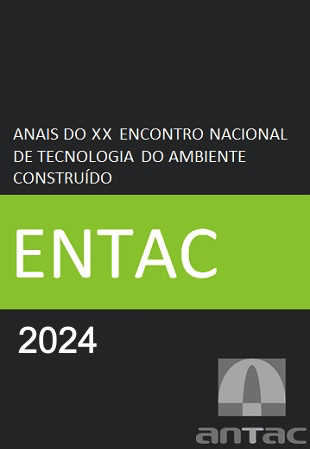Influence of Urban Morphology on the Solar Potential of nZEB Building Envelopes
DOI:
https://doi.org/10.46421/entac.v20i1.6318Keywords:
Urban Morphology, H/W Ratio, Nearly Zero Energy Building (NZEB), Building Integrated Photovoltaics (BIPV), Photovoltaic Integrated Shading Devices (PVSD)Abstract
Nearly Zero Energy Buildings (NZEBs) emerge as a promising approach to reduce greenhouse gas emissions caused by the high energy consumption of the building sector. In this context, the generation of photovoltaic energy integrated into the building envelopes presents itself as one of the key strategies to achieve the goals of NZEBs. This study investigates how urban morphology affects solar availability in a hypothetical office building model located at three different latitudes: Belém, Brasília, and Porto Alegre. Through computational simulations and optimization algorithms, urban parameters such as the aspect ratio (ratio of building height to the width of the distance between buildings) were examined to assess the impact of the surroundings on the solar potential of the envelope. The results reveal that the urban configuration, represented by the H/W Ratio, has a significant effect on energy efficiency and solar energy production on façades, showing a strong relationship with the potential to achieve the nZEB goal. Finally, the analysis highlights the importance of urban planning in maximizing local solar energy generation.
References
GLOBAL ABC (Global Alliance for Buildings and Construction). Relatório de situação Global 2020 para Edifícios e Construção. ONU, 2020.
D’AGOSTINO, Delia; MAZZARELLA, Livio. What is a Nearly zero energy building? Overview, implementation and comparison of definitions. Journal of Building Engineering, [s. l.], v. 21, p. 200–212, jan. 2019. ISSN 23527102. DOI 10.1016/j.jobe.2018.10.019.
FENG, Wei … LAU, Stephen Siu Yu. A review of net zero energy buildings in hot and humid climates: Experience learned from 34 case study buildings. Renewable and Sustainable Energy Reviews, [s. l.], v. 114, p. 109303, 1 out. 2019. ISSN 1364-0321. DOI 10.1016/j.rser.2019.109303.
BRASIL. Portaria INMETRO Nº 309, de 15 de agosto de 2022. Aprova a Instrução Normativa Inmetro para a Eficiência Energética das Edificações Comerciais, de Serviços e Públicas. Diário Oficial da União, Brasília, DF, 17 ago. 2022. Seção 1, p. 45. Anexo I.
FREITAS, Sara; BRITO, Miguel Centeno. Solar façades for future cities. Renewable Energy Focus, [s. l.], v. 31, p. 73–79, dez. 2019. ISSN 17550084. DOI 10.1016/j.ref.2019.09.002.
GHOLAMI, Hassan; NILS RØSTVIK, Harald; STEEMERS, Koen. The Contribution of Building-Integrated Photovoltaics (BIPV) to the Concept of Nearly Zero-Energy Cities in Europe: Potential and Challenges Ahead. Energies, [s. l.], v. 14, n. 19, p. 6015, 22 set. 2021. ISSN 1996-1073. DOI 10.3390/en14196015.
CRONEMBERGER, Joára; CAAMAÑO-MARTÍN, Estefanía; SÁNCHEZ, Sergio Vega. Assessing the solar irradiation potential for solar photovoltaic applications in buildings at low latitudes – Making the case for Brazil. Energy and Buildings, [s. l.], v. 55, p. 264–272, dez. 2012. ISSN 03787788. DOI 10.1016/j.enbuild.2012.08.044.
DIDONÉ, Evelise Leite; WAGNER, Andreas; PEREIRA, Fernando Oscar Ruttkay. Estratégias para edifícios de escritórios energia zero no Brasil com ênfase em BIPV. Ambiente Construído, [s. l.], v. 14, n. 3, p. 27–42, set. 2014. ISSN 1678-8621. DOI 10.1590/S1678-86212014000300003.
COSTA, João Francisco Walter. Edifícios de balanço energético nulo: um estudo para escritórios em Brasília. [s. l.], p. 329, 2018.
CZACHURA, Agnieszka; KANTERS, Jouri; GENTILE, Niko; WALL, Maria. Solar Performance Metrics in Urban Planning: A Review and Taxonomy. Buildings, [s. l.], v. 12, n. 4, p. 393, 23 mar. 2022. ISSN 2075-5309. DOI 10.3390/buildings12040393.
COSTA, João Francisco Walter; AMORIM, Claudia Naves David; SILVA, Joára Cronemberger Ribeiro. Retrofit guidelines towards the achievement of net zero energy buildings for office buildings in Brasilia. Journal of Building Engineering, [s. l.], v. 32, p. 101680, nov. 2020. ISSN 23527102. DOI 10.1016/j.jobe.2020.101680.
LOHWANITCHAI, Kittisak; JAREEMIT, Daranee. Modeling Energy Efficiency Performance and Cost-Benefit Analysis Achieving Net-Zero Energy Building Design: Case Studies of Three Representative Offices in Thailand. Sustainability, [s. l.], v. 13, n. 9, p. 5201, 6 maio 2021. ISSN 2071-1050. DOI 10.3390/su13095201.
NATANIAN, Jonathan; LUCA, Francesco De; NABONI, Emanuele. From repetition to diversity: workflow for energy-driven optimization of heterogeneous urban blocks in hot climates, 2022.
ROSTAMI, Ehsan; NASROLLAHI, Nazanin; KHODAKARAMI, Jamal. A comprehensive study of how urban morphological parameters impact the solar potential, energy consumption and daylight autonomy in canyons and buildings. Energy and Buildings, [s. l.], v. 305, p. 113904, fev. 2024. ISSN 03787788. DOI 10.1016/j.enbuild.2024.113904.
MARTINS, Michele Agra De Lemos. Sensitivity analysis of urban morphology factors regarding solar energy potential of buildings in a Brazilian tropical context. Solar Energy, [s. l.], v. 137, p. 11–24, nov. 2016. ISSN 0038092X. DOI 10.1016/j.solener.2016.07.053.
BRASIL. Agência Nacional de Vigilância Sanitária. Resolução nº 09, de 16 de janeiro de 2003. Orientação Técnica sobre Padrões Referenciais de Qualidade do Ar Interior, em ambientes climatizados artificialmente de uso público e coletivo. Diário Oficial [da] República Federativa do Brasil. Brasília, 10 jan. 2003a. Seção 1, n. p. 45-53, 2003.

